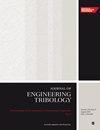Numerical study on sealing performance after wear of plug valve during opening–closing process
IF 1.8
3区 工程技术
Q3 ENGINEERING, MECHANICAL
Proceedings of the Institution of Mechanical Engineers, Part J: Journal of Engineering Tribology
Pub Date : 2023-09-11
DOI:10.1177/13506501231186284
引用次数: 0
Abstract
The failure of the plug valve seal may result in dangerous accidents in the production and transportation process of petroleum and chemical products. In the paper at hand, the operating life of the plug valve is studied in the opening–closing process. The adhesion wear between the sealing surface of the plug valve is numerically studied in micro-scale, and the contact force between the sealing surface is balanced with the internal flow field of the plug valve and the deformation force between the set screw and the spool. The internal flow field of the plug valve in opening–closing process is calculated by finite element method. The deformation coupling model between the set screw and the spool is built to analyze the structure and the mechanics of the plug valve. Then, a leakage identification algorithm based on auto-correlation function is implemented for analyzing contact stress of the plug valve's sealing surfaces after wear. Finally, taking plug valve F-2 ISO-STANDARD as an example, the force of turbulent flow field on the spool is calculated during the closing process. Results show, that while the maximum contact stress increases, the pressure decreases, and the displacement trajectory of spool increases. The operating life decreases by increasing the roughness of the spool sealing surface. The model proposed provides a new practical method to evaluate the operating life of the plug valve, which is a good guidance for the design of the valve.旋塞阀启闭过程磨损后密封性能的数值研究
在石油化工产品的生产和运输过程中,旋塞阀密封的失效可能导致危险事故的发生。本文对旋塞阀在启闭过程中的工作寿命进行了研究。在微观尺度上对旋塞阀密封面之间的粘着磨损进行了数值研究,密封面之间的接触力与旋塞阀内部流场和固定螺杆与阀芯之间的变形力相平衡。采用有限元法对旋塞阀启闭过程中的内部流场进行了计算。建立了螺杆与阀芯之间的变形耦合模型,分析了旋塞阀的结构和力学特性。然后,实现了一种基于自相关函数的泄漏识别算法,分析了旋塞阀密封面磨损后的接触应力。最后,以F-2型ISO-STANDARD旋塞阀为例,计算了旋塞阀关闭过程中湍流流场对阀芯的作用力。结果表明:最大接触应力增大,压力减小,阀芯位移轨迹增大;通过增加阀芯密封面的粗糙度来降低操作寿命。该模型为旋塞阀的使用寿命评估提供了一种新的实用方法,对旋塞阀的设计具有很好的指导意义。
本文章由计算机程序翻译,如有差异,请以英文原文为准。
求助全文
约1分钟内获得全文
求助全文
来源期刊

CiteScore
4.20
自引率
5.00%
发文量
110
审稿时长
6.1 months
期刊介绍:
The Journal of Engineering Tribology publishes high-quality, peer-reviewed papers from academia and industry worldwide on the engineering science associated with tribology and its applications.
"I am proud to say that I have been part of the tribology research community for almost 20 years. That community has always seemed to me to be highly active, progressive, and closely knit. The conferences are well attended and are characterised by a warmth and friendliness that transcends national boundaries. I see Part J as being an important part of that community, giving us an outlet to publish and promote our scholarly activities. I very much look forward to my term of office as editor of your Journal. I hope you will continue to submit papers, help out with reviewing, and most importantly to read and talk about the work you will find there." Professor Rob Dwyer-Joyce, Sheffield University, UK
This journal is a member of the Committee on Publication Ethics (COPE).
 求助内容:
求助内容: 应助结果提醒方式:
应助结果提醒方式:


